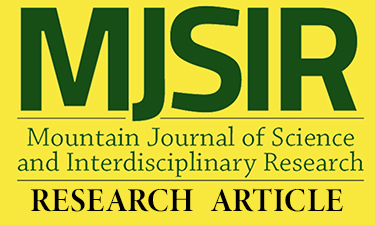Comparison of Floral Diversity of Pine Forest, Agroforestry and Agricultural Land-Uses in Talinguroy Research Station, Benguet State University, Northern Philippines
Main Article Content
Abstract
The Secretariat of the Convention on Biological Diversity identified insufficient knowledge bases as one of main barrier for biodiversity conservation. Additionally, tropical coniferous forest was identified as the least represented biome in terms of local-scale species richness amidst being susceptible to land-use change. This makes the study opportune and much needed as it documented and compared the floral diversity in three landuses, namely agriculture, agroforestry and tropical pine forest, of Talinguroy Research Station, Benguet State University in Cordillera Central Range, Northern Philippines using plot method. A total of 68 species belonging to 63 genera and 40 families was documented, Family Poaceae and Asteraceae being the most represented with 11 and 10 species. Greater Asteraceae and herb species were documented in agricultural plots>agroforesty>forest but indigenous/ endemic species, over-all species diversity, shrub and tree diversity was highest in forest>agroforestry>agricultural plots. Lowest species similarity was observed between agricultural plots and pine forest while highest between agroforestry and pine forest. These results illustrated a direct effect of human disturbance brought by land-use change on species diversity of the area. Greater disturbance resulted to a lower diversity of indigenous and endemic species, lower over-all species diversity, lower shrub and tree diversity but higher herb diversity. Moreover, the study found agriculture to cause more change in species composition than agroforestry. Interestingly, higher Asteraceae species were correlated positively with higher degree of human disturbance. Higher Asteraceae species were positively correlated with higher degree of human disturbance. These information are important baseline information in crafting conservation measures particularly for several endangered indigenous and endemic species in the region.
Comparison
Article Details
References
Barcelona Field Studies Centre. (2018). Simpson’s Diversity Index. https://geographyfieldwork. com/Simpson'sDiversityIndex.htm. Accessed on April 2019.
Barnosky, A. D., Matzke, N., Tomiya S., Wogan, G. O. U. , Swartz B., Quental T.B., et al. (2011). Has the Earth’s sixth mass extinction already arrived? Nature 471:51–57.
Batani R.S., Basbas A., Loncio R., & Napaldet J.T. (in press) Floral Diversity Assessment of Palina River, Kibungan, Benguet, Philippines as Influenced by Environmental Variables
Biodiversity and the 2030 Agenda for Sustainable Development: Technical Note. www.cbd.int/ development/doc/biodiversity-2030-agendatechnical-note-en.pdf
Butchart, S.H.M., Walpole M., Collen B., van Strien, A. J.P.W. Scharlemann, R.E.A. Almond, et al. (2010). Global biodiversity: indicators of recent declines. Science 328:1164–1168.
Guron, M.A., & Napaldet, J.T. (in press) Asteraceae of Mt. Yangbew, Benguet, Philippines.
Holm, G.H., Plucknett, D.L., Pancho, J.V., Herberger, J.P. (1977). The World’s Worst Weeds: Distribution and Biology. University of Hawaii Press, Honolulu, Hawaii, USA, 609 p
Langenberger, G. (2004). A Review of Research on Philippine Forest Vegetation, particularly Work since 1990. Agham Mindanaw 2:11-24.
Lumbres, R.I.C., Palaganas, J.A., Micosa, S.C., Laruan, K.A., Besic, E.D., Yun C-W, Lee Y-J (2014) Diversity assessment in Alno communal mixed forest in Benguet, Philippines. Landscape and Ecological Engeneering 10(2): 361–368
Murphy, G.E.P., Romanuk, T.N. (2016). Data gaps in anthropogenically driven local-scale species richness change studies across the Earth’s terrestrial biomes. Ecology and Evolution 6(9): 2938– 2947.
Napaldet, J.T., & Buot, I.E. Jr. (2019). Diversity of Macrophytes in Balili River, La Trinidad, Benguet as Potential Phytoremediators. Biodiversitas 20(4): 1048-1054
OECD. (2014). Biodiversity and ecosystems. Retrieved from https://www.ncbi.nlm.nih.gov/ pmc/articles/PMC6027986/pdf/emss-78065.pdf
Pacific Open Space, Inc. (n.d.) Plant Dicot Families: Asteraceae (Compositae). http://www. pacificopenspace.com/Resources/Plant%20 Guide/Families/asteraceae.html
Pancho, J.V,. & Gruezo, W.Sm. (1983). Vascular Flora of Mount Makiling and Vicinity (Luzon: Philippines) Part 1. Kalikasan, The Philippine Journal of Biology, Suppl 1, Kalikasan Press, Manila.
Pancho, J.V., & Gruezo, W.Sm. (2006). Vascular Flora of Mount Makiling and Vicinity (Luzon: Philippines) Part 2. National Academy of Science and Technology (NAST) Philippines, Department of Science and Technology, Bicutan, Taguig City and Institute of
Biological Sciences, College of Arts and Sciences, University of the Philippines Los Banos, College, Laguna, Philippines (Publishers), 626 p.
Pancho, J.V., & Gruezo, W.Sm. (2009). Vascular Flora of Mount Makiling and Vicinity (Luzon: Philippines) Part 3. Philippine Agricultural Science 92 (Suppl. 1): S1-S496.
Pancho, J.V., & Gruezo, W.Sm. (2012). Vascular Flora of Mount Makiling and Vicinity (Luzon: Philippines) Part 4. National Academy of Science and Technology (NAST) Philippines, Department of Science and Technology, Bicutan, Taguig City and Institute of Biological Sciences, College of Arts and Sciences, University of the Philippines Los Banos, College, Laguna, Philippines (Publishers), 405 p.
Pancho, J.V., & Obien, S.R. (1995). Manual of Ricefield Weeds in the Philippines, Philippine Rice Research Institute, Nueva Ecija, Philippines. 543pp.
Pelser, P.B., Barcelona, J.F. & Nickrent, D.L. (eds.). (2011) onwards. Co's Digital Flora of the Philippines. www.philippineplants.org.
Philippine Biodiversity Conservation Priorities. (2002). http://www.bmb.gov.ph/downloads/ ActionPlan/PBCP.pdf
Royal Botanic Gardens Kew and Missouri Botanic Garden (n.d.) The Plant List. www.theplantlist. org. Retrieved from May-August 2019
Secretariat of the Convention on Biological Diversity (2018) Biodiversity at the Heart of Sustainable Development: Input to the 2018 High-level Political Forum on Sustainable Development (HLPF).
Turner, B.L. (1997). The Comps of Mexico: A systematic account of the family Asteraceae, vol. 1 – Eupatorieae. Phytologia Memoirs 11: i–iv, 1–272

